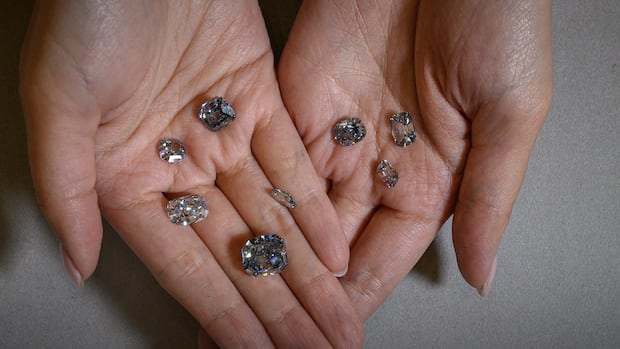When Aret Oymakas started selling diamonds years ago, engagement ring shoppers came in looking for one thing for their brides-to-be: a real, mined diamond.
"It was just a diamond," said Oymakas, owner of Livia Diamonds in Toronto. "And you got what you were able to get … in terms of design and budget."
These days, not so much.
Lab-grown diamonds have become massively popular in recent years, giving the traditional, mined version a run for its money.
Oymakas says natural diamonds made up 100 per cent of his business until 2018 when lab-grown diamonds came on the market in a big way. Now, natural diamonds account for only three to four per cent of his business.
According to experts like Oymakas, ethics, cost and the rising price of every other part of life for new couples has chipped away at the popularity of real diamonds. And that's having a big impact on the mining business — including in Canada's North.
WATCH | Northern mining industry takes a hit as lab-grown diamond popularity surges: Northern mining industry takes a hit as lab-grown diamond popularity surges
Just last week, Burgundy Diamond Mines announced it would be laying off hundreds of employees and temporarily suspending operations at one of its open-pit mining sites, Point Lake, in the Northwest Territories.
A communications manager for the company, Ariella Calin, said the open-pit mine was "proving to be sub-economic," given the recent drop in the value of diamonds. According to data from Tenoris, which tracks diamond retail prices, natural diamonds in stores now cost 26 per cent less than they did just two years ago.
Canada exported $2.21 billion worth of diamonds in 2019, making it the third biggest diamond producer in the world at the time. And with three diamond mines in the Northwest Territories alone, the diamond industry employs thousands of people directly in that province and many more indirectly according to experts, meaning declines in the market will have an outsized impact in the North.
Mined vs. lab grown?
Mined diamonds are forged deep in the earth through heat, pressure and time, before they're dug up, crafted into shape and set into jewelry, such as engagement rings.
Lab-grown diamonds essentially replicate that process above ground — using chemicals and extreme heat, diamonds are forged in a chamber in a matter of weeks.
"I always make the analogy of ice made in your refrigeration system versus ice made outside in the cold," Oymakas said. "Physically they're identical. There's no difference whatsoever."
But some experts stress there is still a difference.
Graham Pearson, professor with the University of Alberta's department of earth and atmospheric sciences, says that the natural formation of diamonds deep underground results in a "complexity" you can't get with the lab-grown variety.
"What you get with [a natural diamond] is that you're holding an amazing fragment of the deepest part of the earth. A natural diamond is unique," he said.
Lab-grown diamonds, he argues, are all the same, made from an exact recipe — like a print of a painting.
Why have people flocked to lab-grown?
To engagement ring shoppers, however, the only visible difference in the price tag, according to Oymakas.
Whereas a two-carat real diamond engagement ring might cost $35,000, Oymakas says a two-carat lab-grown diamond with the same clarity and colour could only be about $3,500.

"With the cost of everything going up these days — housing, wedding expenses — people don't want to spend a fortune on a ring," Oymakas said.
That means people can afford far bigger stones if they buy synthetic, often still for less than what a natural diamond would have cost.
The technology used to make lab-grown diamonds has also dramatically improved since they first came onto the scene, according to Oymakas. He says this allows them to create more customizable stones that have a unique shape or tone for instance, and that's proven to be a draw to customers.
Ethics are another reason. Forced labour and child labour are problems in the diamond mining industry in Africa in particular, and the difficult physical work often yields little pay. Many shoppers want to avoid "blood diamonds" — stones mined in African conflict zones that in turn are used to fund rebel movements. While an international grading system called the Kimberley Process has since been instituted to help consumers know where their diamonds come from, there's still debate about how well the system works.
Stefanie Beninger, an associate professor of marketing at Nyenrode Business University in the Netherlands who has researched the marketing of diamonds, says the ethical component played a big role in the natural diamond's demise.
The blockbuster 2006 movie Blood Diamond starring Leonardo DiCaprio exposed many consumers to the realities of the diamond mining industry. So, years later, when lab-grown diamonds that didn't carry the same ethical concerns emerged on the market, consumers were drawn to them, Beninger said. (Pearson points out that lab-grown diamonds do, however, take a lot of energy to forge in a lab, meaning they're not entirely free of negative impacts either.)
Beyond that, Beringer says the shift has been generational. De Beers's famous "A diamond is forever" slogan sold baby boomers and Gen Xers on diamond engagement rings as a traditional symbol of enduring love, Beninger said.
But millennials aren't buying it. Beringer says that generation, as well as Gen Z, has faced significant financial challenges, on top of being more socially conscious.

"From a functional perspective, [synthetic diamonds] work the same. It's a lot cheaper, and it's more traceable where this came from," Beninger said.
And, Beninger says fewer millenials are getting married compared to their parents or grandparents — a Pew Research study found that as of 2021, 25 per cent of 40-year-olds had never been married, a new record. In 1980, that figure was just six per cent.
The diamond industry launched a "Real is rare" campaign in 2016, Beninger points out, which attempted to market real diamonds to millennials in a less traditional way.
In looking at the sales of lab grown versus natural diamonds, Beninger says it's clear that the campaign didn't pull them back to the mined variety. The idea of a mined diamond as "real" and a lab-grown one as fake just hasn't stuck with younger generations, Beninger said.
Northern mining business in trouble
For Oymakas, lower diamond prices haven't hurt his business. He says while the price of the rock itself has dropped, people are buying bigger synthetic diamonds or perhaps buying more jewelry because the price is more affordable.
LISTEN | The N.W.T.'s diamond mines lost millions of dollars in 2024: The TrailbreakerThe N.W.T.’s diamond mines lost millions of dollars in 2024.
But it's a different story for Canada's North, where thousands of people are directly employed in diamond mines in the Northwest Territories.
"That region of the country in a lot of cases depends on diamonds for [its] livelihood," Zimnisky said.
There are three diamond mines in the Northwest Territories — and all of them are now winding down operations. Diavik diamond mine is set to close early next year, while the Gahcho Kué mine's estimated lifespan is set to 2031.
Pearson says the closure of the industry in Canada's North will have a "tremendous" impact — with what Pearson estimates would result in 1,500 direct jobs and many more indirect ones lost, plus an exodus of people from northern communities.
The Ekati diamond mine, which the Point Lake mine is part of, was the first in the country when it opened in 1998. To have the industry shutter after only 30 years would be a shame, says Pearson.
"It took many, many years and many millions of dollars worth of effort to just find the diamonds ... and it might all be over soon," Pearson said. "That would be an absolute tragedy."
.png)


![A Rigorous Approach to the Algorithmic Composition of Iannis Xenakis(2009) [pdf]](https://news.najib.digital/site/assets/img/broken.gif)

